 W
WThe AC 58 is an anti-armour rifle grenade used by the French Army. Its official French Army designation is Grenade à fusil antichar de 58 mm Mle F1 PAB.
 W
WThe Ampulomet was an expedient anti-tank weapon which launched a 125 mm incendiary projectile made of spherical glass. This weapon was introduced in 1941 and used by the Red Army in World War II, but by 1942 was largely obsolete.
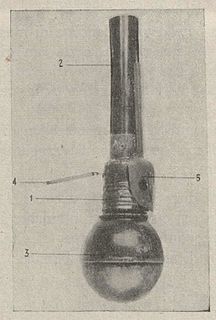 W
WThe Breda Mod. 42 was an anti-tank grenade, developed by Breda, supplied to the Royal Italian Army during World War II.
 W
WThe Gammon bomb, officially known as the No. 82 grenade was a British hand grenade used during World War II.
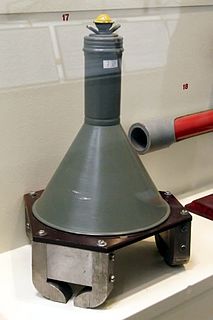 W
WThe Hafthohlladung, also known as the "Panzerknacker", was a magnetically adhered, shaped charge anti-tank grenade used by German forces in World War II, and was sometimes described as a mine.
 W
WThe Grenade, Hand, Anti-Tank, No. 75, also known as the "Hawkins grenade" was a British anti-tank hand grenade used during World War II. It was one of a number of grenades developed for use by the British Army and Home Guard in the aftermath of the Dunkirk evacuation. The grenade first appeared in 1942, and was designed to be more versatile than previous grenades, such as the No. 73 grenade and the sticky bomb.
 W
WThe Spanish munitions company Instalaza made two models of rifle grenade during the 1960s. As well as being used by the Spanish Army, the Portuguese Army also used them in the colonial wars that took place in its colonies in Africa.
 W
WThe M9 rifle grenade was a U S anti-tank rifle grenade used during World War II. It was derived as a lighter version of the M10 grenade which was too heavy to be fired to an effective distance from a rifle.
 W
WThe M31 HEAT is a fin-stabilized anti-tank rifle grenade designed in the late 1950s to replace the Belgian ENERGA rifle grenade which was adopted by the US Army and US Marines as an emergency stop-gap measure during the Korean War. Like the ENERGA, it has a nose-initiated, based-detonated HEAT warhead, but unlike the ENERGA, the mechanical impact fuse system is replaced with a less complex and more reliable piezo-electric fuse system which also allows higher angles of impact, up to 65 degrees.
 W
WYugoslavia manufactured two types of rifle grenade, both with the nomenclature of M60. The M60 anti-personnel rifle grenade bore a resemblance to the French M52 rifle grenade. The M60 anti-tank rifle grenade bore a resemblance to the STRIM 65, also of French origin. It could penetrate 200mm of armour.
 W
WThe Grenade, Rifle No. 68 / Anti-Tank was a British anti-tank rifle grenade used during the Second World War and was one of the first operational weapons to utilise the shaped charge principle.
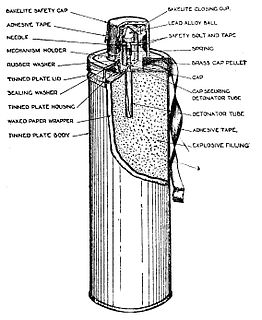 W
WThe No. 73 grenade, also known as the "Thermos", "Woolworth bomb", or "hand percussion grenade", was a British anti-tank grenade used during the Second World War. It got its nickname from the resemblance to a Thermos flask.
 W
WThe Panzerwurfmine was a shaped charge hand-thrown anti-tank grenade used by Luftwaffe ground troops in World War II.
 W
WP Bombs or Passaglia Grenades or Pazzaglia are homemade weapons used by Italian soldiers during World War II especially in the North African theater to overcome the chronic lack of effective weapons against armored enemies.
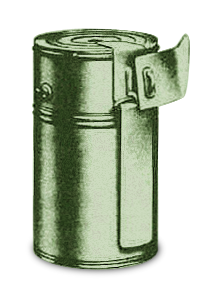 W
WThe Soviet RG-41 was a fragmentation grenade developed during World War II. It was in production for only short time from 1941 to 1942 before being replaced by RG-42.
 W
WRKG-3 is a series of Russian anti-tank hand grenades. It superseded the RPG-43, RPG-40 and RPG-6 series of grenades. It entered service in 1950, but was still used by Iraqi and Afghan insurgents in the 2000s and 2010s, against vehicles of NATO forces.
 W
WThe RPG-40 was an anti-tank hand grenade developed by the Soviet Union in 1940.
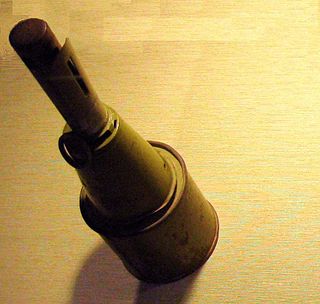 W
WThe RPG-43 was a high explosive anti-tank (HEAT) hand grenade used by the Soviet Union during the Second World War. It entered service in 1943, replacing the earlier models RPG-40 and RPG-41. The RPG-43 used a shaped charge HEAT warhead, whereas the RPG-40 used the simpler HE warhead. The RPG-43 had a penetration of around 75 mm of rolled homogeneous armour at a 90 degree angle. Later in the war, it was improved and became the RPG-6.
 W
WThe "Grenade, Hand, Anti-Tank No. 74", commonly known as the S.T. grenade or sticky bomb, was a British hand grenade designed and produced during the Second World War. The grenade was one of a number of ad hoc anti-tank weapons developed for use by the British Army and Home Guard after the loss of many anti-tank guns in France after the Dunkirk evacuation.
 W
WThe STRIM 65 is an anti-tank rifle grenade that the French Army used from 1961 to 1978, under the designation 65 AC 28. This and the older 73mm Modèle 1950 were the standard anti-tank munitions in French service. A 22 mm grenade launching adapter mounted atop the rifle's barrel held the grenade until the firing of a ballistite (blank) cartridge provided the propulsive force to launch the grenade.
 W
WThe Type 3 "Anti-Tank" Hand Grenade is a Japanese grenade produced from 1943 to 1945 during World War II. It was designed to destroy the Allies' tanks. There are three variants (sub-types) of the weapon: Ko, Otsu, and Hei.
 W
WThe Type 06 rifle grenade is a rifle grenade used by the JGSDF. It can be launched from the Howa Type 89 or Howa Type 64 rifles without other attachments.
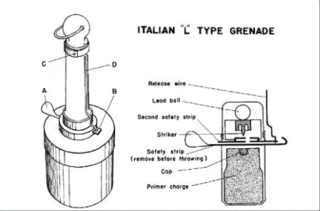 W
WThe Type L is an anti-tank hand grenade provided to the Royal Italian Army during World War II.